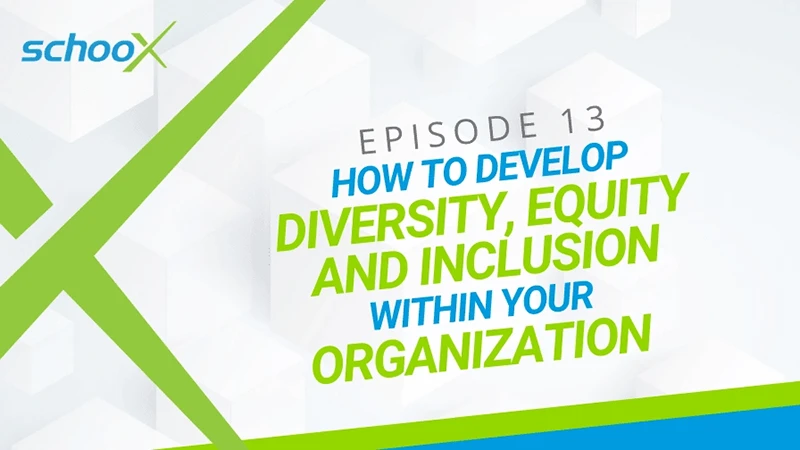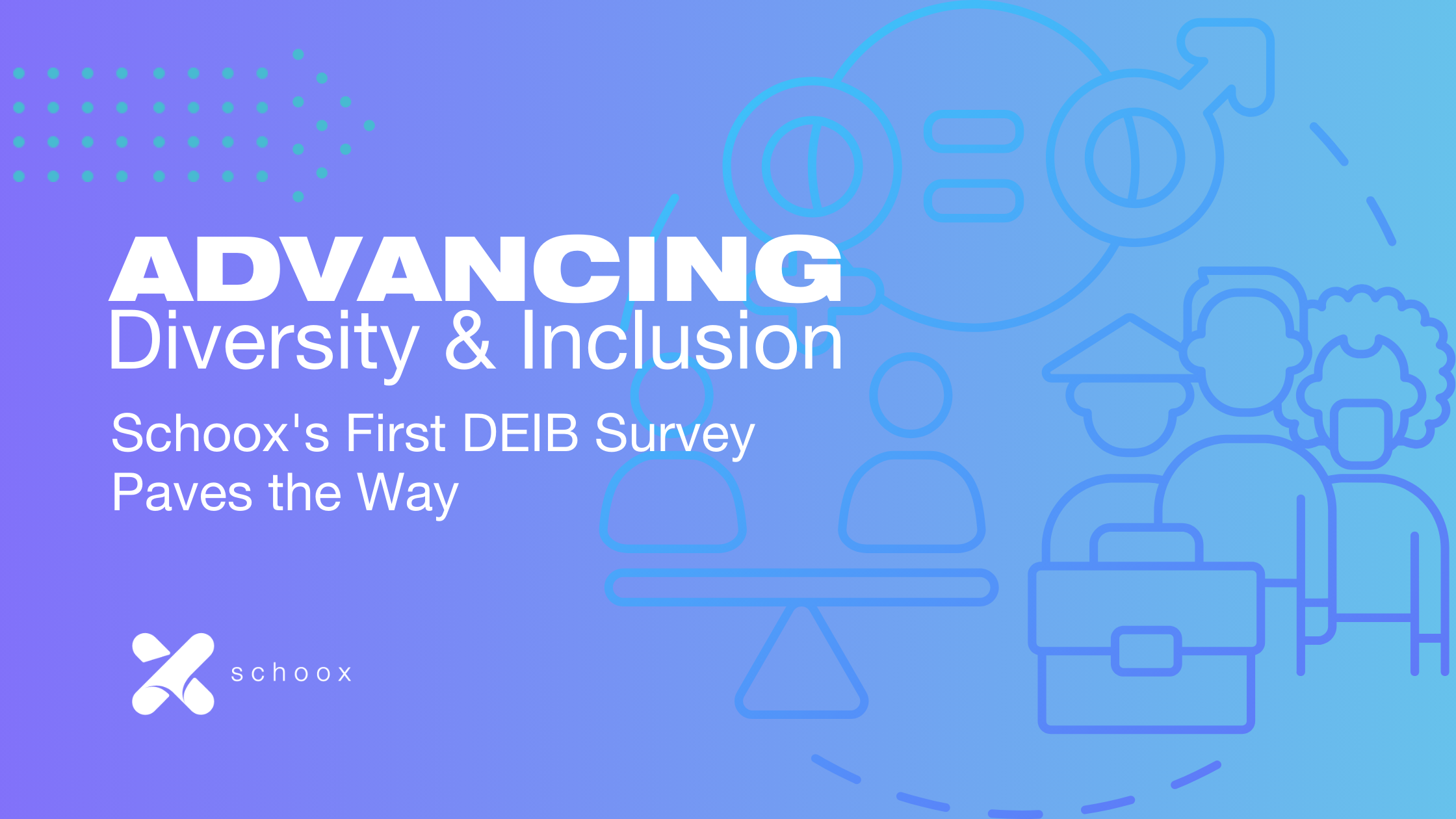January 14, 2021
7 Min. Read

How is diversity, equity, and inclusion defined within your workplace?
The disruptive events of 2020 forced organizations to rethink many areas of their business. New approaches to training, employee engagement, performance reviews, and other practices were developed as a response to the pandemic. In many cases, these developments required organizations to pay increased attention to diversity, equity, and inclusion (DEI) practices within their workplace.
In this episode of The Learning Xchange, Matthew Brown, the VP of Learning and Brand Success at Schoox, discusses recent developments in diversity, equity, and inclusion. He looks at how DEI initiatives are constantly evolving and how the pandemic continues to affect equality challenges within organizations.
How the diversity, equity, and inclusion conversation has developed
Diversity and inclusion have been part of many organizations’ efforts for a long time. But it wasn’t until recently that the focus widened to include ‘equity.’
The table stakes for organizations to enter into diversity, equity, and inclusion conversations have historically been very limited. Often, the topic is linked strictly to racial and gender inequality, fairness, and sometimes stretching to helping the workforce understand different cultures, backgrounds, and experiences.
In 2021, the conversation is evolving. Organizations are expanding their diversity, equity, and inclusion initiatives to include more than just hiring people from diverse backgrounds. Now, organizations are committing to establishing and maintaining a fully diverse, equal, and inclusive company culture.
New opportunities for diversity, equity, and inclusion in recruitment
Last year, many businesses shifted to remote working. Many had resisted previous moves to remote working due to productivity and other concerns. However, as it’s been demonstrated, when the shift is managed appropriately, with boundaries, expectations, and employee support put in place, the benefits far outweigh any negatives.
With no physical workspace, this opens up a greater range of recruitment opportunities. Organizations are no longer limited to hiring new talent within a set radius. Instead, they can look further afield for new employees, whether that’s outside of their city, state, or even country.
This increases the diversity and inclusion opportunities for your organization. It means that you can easily bring people with diverse backgrounds, perspectives and cultures into your business that you couldn’t previously.
However, it’s very important to consider people’s remote working challenges.
Why remote working is a diversity, equity, and inclusion issue
Office spaces are designed to be a productive workspace. Traditional homes often don’t afford people that luxury. Millions of people could be working from their dining room tables, or even from their beds. They might not have a suitable office chair to sit in for a full workday. They might have distractions such as family members, children, or pets.
Having diverse work environments means that there can be a variety of challenges to employees’ productivity that you may not be acutely aware of. Over time, these issues can demotivate people and put increased stress on their ability to work effectively.
Organizations should take the time to think about how they can create more equality for employees across the board. A one-size-fits-all approach won’t work. However, by working with HR, learning, managerial, supervisory, and other teams across the business, you can start to help each person succeed.
The ongoing pandemic challenges for diversity, equity, and inclusion
As vaccine rollout begins, organizations need to plan what their business will look like in the future. If your organization is hoping to move back into a physical workspace, will there be a requirement for every employee to be vaccinated? How will your organization address those who chose not to get vaccinated?
Starting an open, ongoing conversation about vaccines and the plan for your organization is the best way to ensure that all employees can comfortably share their thoughts with you. We’ve previously explored how a communicative culture can help organizations come together. Creating a conversation around DEI challenges is no different.
Why the diversity, equity, and inclusion conversation needs to continue
There is already a need to do so much more around racial inequality and injustice–events in 2020 proved this.
Organizations should be willing to dedicate time and empower teams with the tools and capabilities to provide support. All of this begins with an open dialogue. When organizations listen to people with different perspectives, they can see areas that need to change and begin putting new initiatives in place.
Bringing new perspectives to your organization can wholly benefit them across multiple levels. Not only in terms of employee engagement and success, but it’s been proven that more diverse teams are more successful teams.
Many studies show that diverse teams outperform those which lack diversity. Different thoughts, cultures, and approaches to work often result in greater output and spark creativity in new ways.
The future of diversity, equity, and inclusion
Going forward, HR leaders are increasingly going to focus on ensuring diversity, equity, and inclusion initiatives are in place. These will become more inclusive, incorporating gender and racial equality, flexible working arrangements, physical, mental, and financial health initiatives, and more.
We can also expect to see a greater focus on mental health and wellness. This is already playing a big part in many companies and will become more developed and widespread.
One trend that organizations should be prepared for is ‘cancel culture.’ This can have a huge impact on diversity, equity, and inclusion practices, so it’s important to be aware of how it can be addressed if and when it arises within your organization.
Diversity, equity, and inclusion within your organization
How does your organization define diversity, equity, and inclusion? Organizations that prioritize thinking critically about and questioning their DEI approach will drive change within their industries so it’s important on many levels to make it a priority.
We recommend using third-party, off-the-shelf content to introduce DEI practices and begin the conversation within your organization. There are many companies that have spent time crafting tools and resources to define DEI, set minimum expectations, and present best practices.
There’s no need for your company to delay introducing this conversation. You don’t need to reinvent the wheel and create a diversity, equity, and inclusion program from scratch. You can use existing materials to educate and inform before you translate it into what that means for your company.
We encourage all organizations to make diversity, equity, and inclusion a priority in 2021 and advance the conversation so that everyone is afforded equal opportunities to succeed.
Thank you for reading about The Learning Xchange, the podcast from Schoox. The Learning Xchange is our weekly feature that focuses on the ever-changing landscape of online learning and talent management. It’s available to access here, on our website, as blogs or on your favorite podcast channel.


